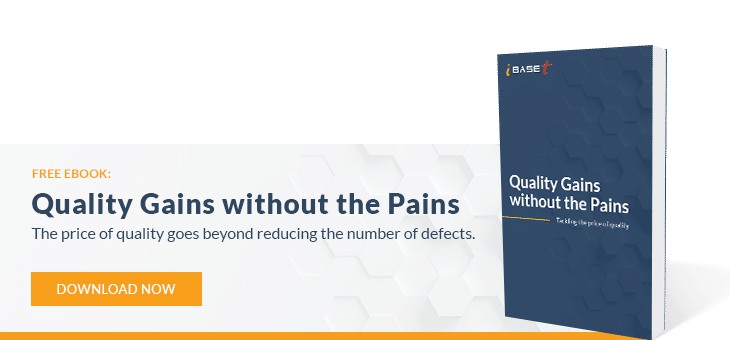Evaluating the entire quality management system is essential, because, in complex manufacturing, addressing quality goes beyond reducing the number of defects. Doing things right the first time, every time, is not as easy as it sounds. Many production processes have sources of variability and tolerance of error. To minimize the issues and defects that arise from those margins of error, a Quality Management System (QMS) is required. Guidelines for a full QMS have been developed and documented during the last few decades by industry standards such as ISO9001, AS9100, and ISO13485.
Our new e-book, Quality Gains without the Pains, addresses the subject in detail.
Understanding the Cost of Quality
The most widely accepted method for measuring and classifying quality costs is the Prevention, Appraisal, and Failure (PAF) model that divides quality costs into four categories: Prevention, Appraisal, Internal Failure and External Failure.
Research shows that the cost of poor quality (including rework, returns, and reduced repeat sales) can range from 15 to 35 percent of business costs. Typically, the cost to address a mistake found by the customer (external quality failure) is five to ten times greater than the cost of finding the problem internally sooner. There are also many ripple effects from an unplanned rework that impact the optimized planned production schedule. It pays to understand the true cost of quality and work to optimize your quality management system.
Approaches to Driving Down the Cost of Quality
- Reduce the Number of Defects
- Make Processes More Efficient
- Engage in Effective Prevention Measures
- Digitize Work Instructions
- Streamline Certification and Verification Processes for Personnel
- Calibrate Tools Based on Actual Usage
- Implement More Efficient Quality Appraisal Processes
- Automate Statistical Process Control
- Accommodate the Extended Supply Chain
- Set-Up Process Audits
- Document Discrepancies in Detail
QUALITY MANAGEMENT SYSTEM CONSIDERATIONS
There is a natural cost trade-off between how much an organization spends on prevention versus how much it spends on fixing failures. In addition to the traditional way of lowering the cost of quality by reducing the number of defects, it is possible to tackle the efficiency of the quality management system (QMS) itself to further reduce cost of quality.






